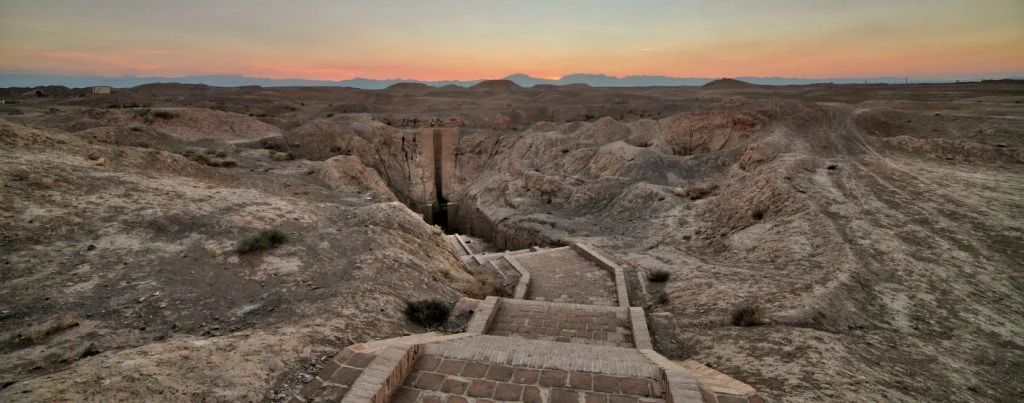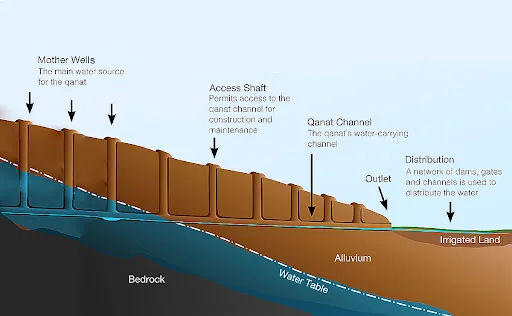
Ghasabeh Qanat
One of the unique experiences of traveling in Iran is visiting the Ghasabeh Qanat. Tucked away in a small, dusty town far from the crowded, tourist-heavy cities of Isfahan and Shiraz, this ancient marvel invites you to explore a remarkable underground channel that winds beneath the desert for over 33 kilometers, accessible through 472 shafts. At its deepest point, the channel lies 300 meters below ground. It’s astonishing to think that, 2,500 years ago, people managed to create a nearly level shaft that still today transports 150 liters of water per second to this location and beyond to the surrounding areas of Gonabad (go-NAW-bawd).
The Ghasabe (also known as Qasabeh) Qanats in the town of Gonabad, located in northeast Iran, are among the oldest and most impressive qanats in the world. Constructed between 700 BC and 500 BC by Cyrus the Great and other ancient rulers, these engineering marvels stand as a testament to Iran’s rich history. In 2016, they were recognized for their historical significance and inscribed as a UNESCO World Heritage Site under the name “The Persian Qanat.”

Historical Background
Persian Era
Callisthenes notes that by 328 BCE, the Persians had already adopted water clocks to meticulously and equitably manage the distribution of water from qanats to their stakeholders for agricultural use. The use of these water clocks in Iran, particularly in the Qanats of Gonabad and Kariz Zibad, dates back to 500 BCE. Over time, water clocks also played a crucial role in determining the exact dates of pre-Islamic religious observances, such as Nowruz, Chelah, and Yaldā—the shortest, longest, and equal-length days and nights of the year. Known as the Fenjaan, this device was the most accurate and widely used method for measuring the time or amount of water a farmer could draw from the Qanats of Gonabad until it was eventually replaced by more modern timekeeping devices.
Kariz Gonabad Iran
the oldest water clock in Persia. Qanat- e Zibad- Gonabad water clock
The Persian scholar Nasir Khusraw (1003–1077) referred to the Qanats of Gonabad as the Kariz of Kai Khosrow, attributing their construction to the legendary Persian king Kai Khosrow. Some scholars speculate that Kai Khosrow may be the same individual as Cyrus the Great. A contemporary inscription from 714 BCE recounts how Sargon II of Assyria, during his invasion of Uhlu—located northwest of Lake Uroomiye and within Urartian territory—noted the area’s lush vegetation despite the absence of a river. This greenery was attributed to Ursa, the region’s king, who had alleviated the population’s water shortage and transformed Uhlu into a thriving, verdant land. Goblot suggests that the technological advancement of qanats, influenced by the Medes and Achaemenids, spread from Urartu (in northwest Iran, near the modern border with Turkey) across the Iranian plateau.
Under Achaemenid rule, a decree was issued that waived taxes for anyone who successfully constructed a qanat to bring groundwater to the surface for agricultural use, or who renovated an abandoned qanat. This tax exemption extended not only to the individual but also to their descendants for up to five generations. Acting on Darius’ orders, Silaks, the Persian naval commander, and Khenombiz, the royal architect, successfully constructed a qanat in the Kharagha oasis in Egypt. Beadnell posits that qanat construction began in two distinct phases: initially by the Persians, and later by the Romans during their occupation of Egypt from 30 BCE to 395 AD. The grand temple erected in this region during Darius’ reign indicates a substantial population reliant on qanat water, with Ragerz estimating around 10,000 people. Polybius provides a key historical account, noting that “streams are flowing from everywhere at the base of the Alborz mountains, and people have transferred water over long distances through subterranean canals at great cost and effort.” The government maintained and repaired qanats that were abandoned or damaged and built new ones as needed. A Pahlavi document underscores the crucial role qanats played in the development of cities during this period.

